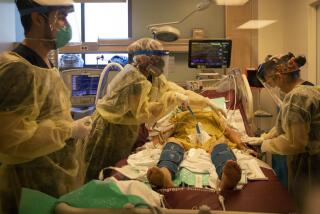The big post-pandemic educational mess and what it will take to solve it

- Share via
When states shuttered public schools for in-person learning last March, almost no one imagined that some of them would remain closed for a full year or more. As time passed, concerns about a limited “learning loss” grew into worries about a “lost generation” of students. Projections of lost achievement were massive.
But when student performance data started trickling in during the fall, the results were not as terrible as many had envisioned. Yes, performance seemed to be dipping, especially for the most vulnerable, but the magnitude of the decline appeared smaller than the direst predictions.
As a result, some education scholars and activists decided they’d been too pessimistic. Now they began arguing that “there is no such thing as learning loss.” When the Biden administration called on states to actually test their students to gauge the impact of the pandemic, there was intense resistance to even measuring what the pandemic hath wrought.
Unfortunately, that newfound complacency was unjustified. The truth is that, while the early and worst concerns may not have been realized, evidence from a wide range of sources makes clear that the serious negative consequences of the pandemic are real, large and disproportionately hit the most disadvantaged.
The newest and best data come from Curriculum Associates, a company that provides tests and curriculum to schools. Its report analyzing data through the winter found that 10% more students are reading below grade level in early elementary school than in prior years and 16% more students have fallen behind in mathematics by the fourth grade. These dips are larger in schools with more Black, Latino and low-income students. And the dips may be especially pronounced for students who were lower-achieving before the pandemic — now nearly 40% of third-graders in majority-Black schools are two or more grades below grade level.
And the negative consequences of the closures aren’t restricted to test scores; parents and the public are noticing them, too. A recent national survey of parents of teenagers found that 46% have noticed a new or worsening mental health condition in their children — even more for teen girls.
Yes, there are undoubtedly some good things happening with kids at home. But it’s unlikely they outweigh the serious social, emotional and academic impacts of the virus and school closings.
Fortunately, the American Rescue Plan, signed into law by President Biden earlier this month, is offering enormous resources to school districts to address these negative effects. In the most disadvantaged districts — such as Los Angeles Unified — more than $10,000 is being provided per pupil to address the crisis.
Unfortunately, our educational systems and structures are incredibly poorly designed from the standpoint of identifying what works and then providing it equitably to students and families. We have 13,000 school districts in the country, each with its own school board, parent groups, and (in many cases) teachers union, each trying to figure out how to reopen and how to begin targeting interventions and supports to those who need them most. “Local control” is generally touted as a virtue, even among progressives who otherwise recognize that equal opportunity can best be ensured by higher levels of government.
This is where state and national leaders simply must step in. They need to provide clear and specific guidance on the best ways to spend American Rescue Plan dollars to address the negative impacts of the pandemic on children and families. They must not leave decisions to local actors — burdening them with the task of figuring out what works and implementing it.
The state and federal governments don’t need to be unreasonably prescriptive; some decisions will have to be left to local districts. But all solutions must contain at least three elements.
First, we need accurate, ongoing measurement — not just of student learning (and yes, that means state tests), but also of student social and emotional health and well-being. Solving problems must begin with identifying where the problems are and who they affect. States should craft multiyear measurement plans, so we can follow our progress well beyond the end of the pandemic. And measurement plans should be carefully constructed to ensure the results are directly useful for informing instructional and other decisions.
Second, we need specific, high-quality interventions in the educational process that are either supported or directly provided by centralized organizations (likely governments themselves). These should include high-quality tutoring, which has a long track record of boosting learning. But they could also include extended school days and school years, high-quality curriculum materials that can be used in distance learning and social and emotional supports like added counselors.
Last, these interventions need to be targeted to those who need them most, which means providing extra resources to low-income communities and communities of color. Fortunately, the American Rescue Plan does this through its funding approach. Interventions should be designed in collaboration with community leaders, not merely imposed. The pandemic’s effects were not equally felt, so the response must not be equally provided.
Simply put, we can’t undo the negative effects of this national crisis on our children with 13,000 districts working independently. We must not allow our dysfunctional educational systems to block the serious response that our children need.
Morgan Polikoff, an associate professor of education at USC, is the author of “Beyond Standards: The Fragmentation of Education Governance and the Promise of Curriculum Reform.”
More to Read
A cure for the common opinion
Get thought-provoking perspectives with our weekly newsletter.
You may occasionally receive promotional content from the Los Angeles Times.









